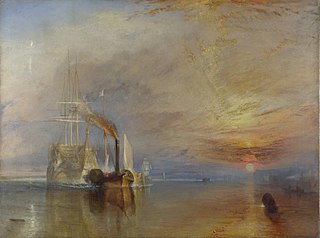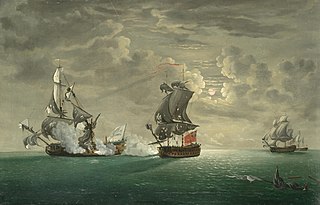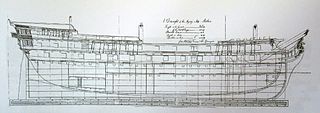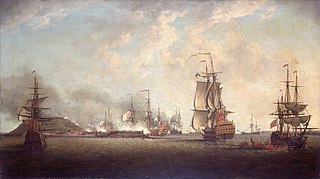
The Battle of the Saintes, also known as the Battle of Dominica, was an important naval battle in the Caribbean between the British and the French that took place 9–12 April 1782. The British victory was considered their greatest over the French during the American Revolutionary War.

HMS Temeraire was a 98-gun second-rate ship of the line of the United Kingdom's Royal Navy. Launched in 1798, she served during the French Revolutionary and Napoleonic Wars, mostly on blockades or convoy escort duties. She fought only one fleet action, the Battle of Trafalgar, but became so well known for that action and her subsequent depictions in art and literature that she has been remembered as The Fighting Temeraire.

HMS Monmouth was a 66-gun third-rate ship of the line of the Royal Navy, and was likely named for James, Duke of Monmouth. She served from 1667 to 1767, winning ten battle honours over a century of active service. She was rebuilt a total of three times during her career—each time effectively becoming a completely new ship.

HMS Ajax was a 74-gun third rate ship of the line of the Royal Navy, built by Thomas Bucknall at Portsmouth Dockyard and launched on 23 December 1767. She was designed by William Bateley, and was the only ship built to her draught. She had a crew of 600 men.

HMS Arrogant was a 74-gun third rate ship of the line of the Royal Navy, built of Suffolk oak by John Barnard and launched on 22 January 1761 at King's Yard Harwich. She was the first of the Arrogant-class ships of the line, designed by Sir Thomas Slade.

HMS Prince George was a 90-gun second-rate ship of the line of the Royal Navy, launched on 31 August 1772 at Chatham. During her career, she was upgraded to a 98-gun ship, through the addition of eight 12-pounder guns to her quarterdeck.

HMS Formidable was a 98-gun second rate man-of-war serving the Royal Navy.

HMS Alcide, the French and Italian version of "Alcides", another name for Heracles, was a 74-gun third-rate ship of the line of the Royal Navy, designed by Sir Thomas Slade and built by Adam Hayes at Deptford Dockyard being launched on 30 July 1779.

HMS Duke was a 98-gun second rate ship of the line of the Royal Navy, launched on 18 October 1777 at Plymouth.
HMS Conqueror was a 74-gun third rate ship of the line of the Royal Navy, built by Israel Pownoll and launched on 10 October 1773 at Plymouth.
HMS Alfred was a 74-gun third rate ship of the line of the Royal Navy, launched on 22 October 1778 at Chatham Dockyard.

HMS America was a 64-gun third-rate ship of the line of the Royal Navy, designed by John Williams and built by Adam Hayes at Deptford Dockyard and was launched on 5 August 1777. The name was a traditional name in the Royal Navy and continued unabated despite the American War of Independence in 1776.

HMS Royal Sovereign was a 100-gun first rate ship of the line of the Royal Navy, built at Woolwich Dockyard and launched in July 1701. She had been built using some of the salvageable timbers from the previous Royal Sovereign, which had been destroyed by fire in 1697.

The Foudroyant was an 80-gun ship of the line of the French Navy. She was later captured and served in the Royal Navy as the Third Rate HMS Foudroyant.

Téméraire was a 74-gun ship of the line of the French Navy, ordered in December 1747 to a design by François Coulomb, and built at Toulon by his cousin, the constructor Pierre-Blaise Coulomb; she was launched on 24 December 1749. Her 74 guns comprised:
28 x 36-pounders on the lower deck
30 x 18-pounders on the upper deck
10 x 8-pounders on the quarterdeck
6 x 8-pounders on the forecastle.
Princesa was a 70-gun, two deck, ship of the line of the Spanish Navy, one of three ordered in 1748 to the specification laid down by Ciprian Autran and designed and built at Havana by Pedro de Torres. She was laid down on 11 May 1748 and launched on 15 September 1750. She and her sisters Infante and Galicia were commissioned together on 15 August 1751, and left Havana on 1 March 1752 as a squadron under the overall command of Jefe de escuadra Francisco Ponce de Leon, arriving at Cadiz on 30 April.

Protée was an Artésien-class 64-gun ship of the line of the French Navy, launched in 1772.

HMS Neptune was a 90-gun second-rate ship of the line of the Royal Navy. She was built under the 1677 "Thirty Great Ships" Programme and launched in 1683 at Deptford Dockyard.

HMS Essex was a 70-gun third rate built by Sir Henry Johnson of Blackwall in 1678/79. During the War of the English Succession she fought in the last major action. She was rebuilt in 1699/1700. During the War of Spanish Succession she fought at Vigo Bay, the Capture of Gibraltar and Velez Malaga. She also fought at the Battle off Passero in 1718. She was rebuilt again in 1736-40. She was in action off Toulon in 1744. She was active in the Channel and against French ports during the Seven Years War. She fought at Quiberon Bay in 1759. She was wrecked in Quiberon Bay in November 1759.

HMS Swiftsure was a 70-gun third-rate ship of the line of the Royal Navy, launched in 1755 and in active service during the Seven Years' War. After a distinguished career at sea she was decommissioned in 1763 and sold into private hands ten years later.

















